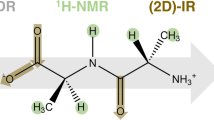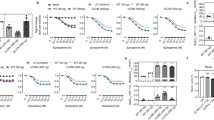Abstract
The receptor tyrosine kinase encoded by the neu/erbB-2 proto-oncogene is constitutively activated by a single valine to glutamic acid substitution at position 664 in the predicted membrane-spanning sequence of the receptor. We have explored the structural changes involved in receptor activation with polarized FTIR and magic angle spinning NMR spectroscopy. The hydrophobic transmembrane sequence folds into a well-defined α-helical structure spanning the membrane bilayer. Measurements of the pKa and 13C chemical shift anisotropy of Glu 664 reveal that the side chain carboxyl group is protonated and strongly hydrogen bonded. These studies provide direct evidence for glutamate hydrogen-bonding interactions in the mechanism of receptor dimerization and activation.
This is a preview of subscription content, access via your institution
Access options
Subscribe to this journal
Receive 12 print issues and online access
$189.00 per year
only $15.75 per issue
Buy this article
- Purchase on Springer Link
- Instant access to full article PDF
Prices may be subject to local taxes which are calculated during checkout
Similar content being viewed by others
References
Schlessinger, J. & Ulrich, A. Growth factor signalling by receptor tyrosine kinases. Neuron 9, 383–391 (1992).
Hynes, N.E. & Stern, D.F. The biology of erbB-2/neu/HER-2 and its role in cancer. Biochim. Biophys. Acta 1198, 165–184 (1994).
Bargmann, C.I., Hung, M.-C. & Weinberg, R.A. Multiple independent activations of the neu oncogene by a point mutation altering the transmembrane domain of p185. Cell 45, 649–657 (1986).
Bargmann, C.I. & Weinberg, R.A. Oncogenic activation of the neu- encoded receptor protein by point mutation and deletion. EMBO J. 7, 2043–2052 (1988).
Cao, H., Bangalore, L., Bormann, B.J. & Stern, D.F. A subdomain in the transmembrane domain is necessary for p185neu* activation. EMBO J. 11, 923–932 (1992).
Cao, H., Bangalore, L., Dompe, C., Bormann, B.J. & Stern, D.F. An extra cysteine proximal to the transmembrane domain induces differential crosslinking of p185neu and p185neu*. J. Biol. Chem. 267, 20489–20492 (1992).
Sternberg, M.J. & Gullick, W.J. Neu receptor dimerization. Nature 339, 587 (1989).
Sternberg, M.J.E. & Gullick, W.J. A sequence motif in the transmembrane region of growth factor receptors with tyrosine kinase activity mediates dimerization. Protein Eng. 3, 245–248 (1990).
Brandt-Rauf, P.W., Rackovsky, S. & Pincus, M.R. Correlation of the structure of the transmembrane domain of the neu oncogene encoded p185 protein with its function. Proc. Natl. Acad. Sci. USA 87, 8660–8664 (1990).
Smith, S.O., Jonas, R., Braiman, M.S. & Bormann, B.J. Structure and orientation of the transmembrane domain of glycophorin A in lipid bilayers. Biochemistry 33, 633–641 (1994).
Smith, S.O. & Bormann, B.J. Determination of helix-helix interactions in membranes by rotational resonance NMR. Proc. Natl. Acad. Sci. USA 92, 488–491 (1995).
Surewicz, W.K., Mantsch, H.H. & Chapman, D. Determination of protein secondary structure by fourier transform infrared spectroscopy: a critical assessment. Biochemistry 32, 389–394 (1993).
Braiman, M.S. & Rothschild, K.J. Fourier transform infrared techniques for probing membrane protein structure. Annu. Rev. Biophys. Biophys. Chem. 17, 541–570 (1989).
Byler, M.D. & Susi, H. Examination of the secondary structure of proteins by Deconvolved FTIR spectra. Biopolymers 25, 469–487 (1986).
Venyaminov, S.U. & Kalnin, N.N. Quantitative IR spectroscopy of peptide compounds in water (H2O) solutions. II. Amide absorption bands of polypeptides and fibrous proteins in alpha-, beta-, and random coil conformations. Biopolymers 30, 1259–1271 (1990).
Venyaminov, S.U. & Kalnin, N.N. Quantitative IR spectrophotometry of peptide compounds in water (H2O) solutions. III. Estimation of the protein secondary structure. Biopolymers 30, 1273–1280 (1990).
Venyaminov, S.U. & Kalnin, N.N. Quantitative IR spectroscopy of peptide compounds in water (H2O) solutions. I. Spectral parameters of amino acid residue absorption bands. Biopolymers 30, 1243–1257 (1990).
Kauppinen, J.K., Moffatt, D.J., Mantsch, H.H. & Cameron, D.G. Fourier self-deconvolution: a method for resolving intrinsically overlapped bands. Appl. Spectrosc. 35, 271–276 (1981).
Chothia, C., Levitt, M. & Richardson, D. Helix-to-helix packing in proteins. J. Mol. Biol. 145, 215–250 (1981).
Arkin, I.T., Rothman, M., Ludlam, C.F.C., Aimoto, S., Engelman, D.M., Rothschild, K.J. & Smith, S.O. Structural model of the phospholamban ion channel complex in phospholipid membranes. J. Mol. Biol. 248, 824–834 (1995).
Kantor, H.L. & Prestegard, J.P. Fusion of phosphatidylcholine bilayer vesicles: role of free fatty acid. Biochemistry 17, 3592–3597 (1978).
Tsui, F.C., Ojcius, D.M. & Hubbell, W.L. The intrinsic pKa values for phosphatidylserine and phosphatidylethanolamine in phosphatidylcholine host bilayers. Biophys. J. 49, 459–468 (1986).
Ptak, M., Egret-Charlier, M., Sanson, A. & Bouloussa, O. A NMR study of the ionization of fatty acids, fatty amines and N-acylamino acids incorporated in phosphatidylcholine vesicles. Biochim. Biophys. Acta 600, 387–397 (1980).
Adams, G.A. & Rose, J.K. Structural requirements of a membrane-spanning domain for protein anchoring and cell surface transport. Cell 41, 1007–1015 (1985).
Gu, Z., Zambrano, R. & McDermott, A. Hydrogen bonding of carboxyl groups in solid-state amino acids and peptides: comparison of carbon chemical shielding, infrared frequencies, and structures. J. Am. Chem. Soc. 116, 6368–6372 (1994).
Herzfeld, J. & Berger, A.E. Side band intensities in NMR spectra of samples spinning at the magic angle. J. Chem. Phys. 73, 6021–6030 (1980).
Sequeira, A., Rajagopal, H. & Chidambaram, R. A neutron diffraction study of the structure of L-glutamic acid.HCL. Acta Crystallogr. B28, 2514–2519 (1972).
Miyazaki, J., Hideg, K. & Marsh, D. Interfacial ionization and partitioning of membrane-bound local anaesthetics. Biochim. Biophys. Acta 1103, 62–68 (1992).
Gullick, W.J. et al. Three dimensional structure of the transmembrane region of the proto-oncogenic and oncogenic forms of the neu protein. EMBO J. 11, 43–48 (1992).
Lofts, F.J., Hurst, H.C., Sternberg, M.J.E. & Gullick, W.J. Specific short transmembrane sequences can inhibit transformation by the mutant neu growth factor receptor in vitro and in vivo. Oncogene 8, 2813–2820 (1993).
Downward, J. et al. Close similarity of epidermal growth factor receptor and v-erb-B oncogene protein sequences. Nature 307, 521–527 (1984).
Birchmeier, C., Birnbaum, D., Waitches, G., Fasano, O. & Wigler, M. Characterization of an activated human ros gene. Mol. Cell Biol. 6, 3109–3116 (1986).
Gamett, D.C., Tracey, S.E. & Robinson, H.L. Differences in sequences encoding the carboxyl-terminal domain of the epidermal growth factor receptor correlate with differences in disease potential of viral erbB genes. Proc Natl. Acad. Sci. USA 83, 6053–6057 (1986).
Neckameyer, W.S., Shibuya, M., Hsu, M.-T. & Wang, L.-H. Proto-oncogene c-ros codes for a molecule with structural features common to those of growth factor receptors and displays tissue-specific and developmentally regulated expression. Mol. Cell Biol. 6, 1478–1486 (1986).
Harrick, N.J. Internal reflection spectroscopy. Interscience Publishers, New York (1967).
Wolfe, W.F. & Zissis, G.J. in The Infrared Handbook ( U.S. Government Printing Office, Washington 1978).
Fringeli, U.P., Apell, H.J., Fringeli, M. & Lauger, P. Polarized infrared absorption of Na+/K+-ATPase studied by attenuated total reflection spectroscopy. Biochim. Biophys. Acta 984, 301–312 (1989).
Tamm, L.K. & Tatulian, S.A. Orientation of functional and nonfunctional PTS permease signal sequences in lipid bilayers. A polarized attenuated total reflection infrared study. Biochemistry 32, 7720–7726 (1993).
Miyazawa, T. & Blout, E.R. The infrared spectra of polypeptides in various conformations: amide I and amide II bands. J. Am. Chem. Soc. 83, 712–719 (1961).
Bradbury, E.M. et al. The structure of the ω-form of poly-β-benzyl-L-aspartate. J. Mol. Biol. 5, 230–247 (1962).
Tsuboi, M. Infrared dichroism and molecular conformation of α-form poly-γ-benzyl-L-glutamate. J. Polymer Sci. 59, 139–153 (1994).
Author information
Authors and Affiliations
Rights and permissions
About this article
Cite this article
Smith, S., Smith, C. & Bormann, B. Strong hydrogen bonding interactions involving a buried glutamic acid in the transmembrane sequence of the neu/erbB-2 receptor. Nat Struct Mol Biol 3, 252–258 (1996). https://doi.org/10.1038/nsb0396-252
Received:
Accepted:
Issue Date:
DOI: https://doi.org/10.1038/nsb0396-252
This article is cited by
-
Modulation of Transmembrane Domain Interactions in Neu Receptor Tyrosine Kinase by Membrane Fluidity and Cholesterol
The Journal of Membrane Biology (2019)
-
Pentameric ligand-gated ion channels exhibit distinct transmembrane domain archetypes for folding/expression and function
Scientific Reports (2017)
-
A conserved cationic motif enhances membrane binding and insertion of the chloride intracellular channel protein 1 transmembrane domain
European Biophysics Journal (2014)
-
Protein folding in membranes
Cellular and Molecular Life Sciences (2010)
-
Structure analysis of membrane-reconstituted subunit c-ring of E. coli H+-ATP synthase by solid-state NMR
Journal of Biomolecular NMR (2010)



